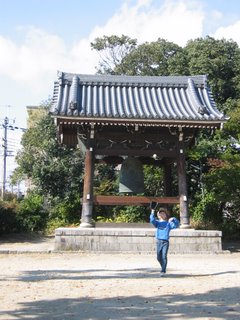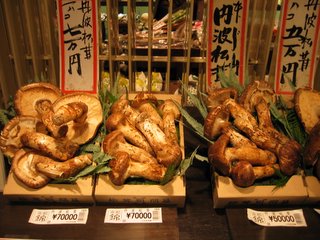 left: Baseball at the temple
left: Baseball at the templeKyoto’s grounds are not pierced with the pointy lances of skyscrapers or cluttered with the trash of her inhabitants. She is a clean, quaint city, one that flaunts her history by way of her dozens of historical temples, gardens, and shrines. Modernity has been pestering Kyoto for decades trying to get its sneaky foot in the door, and although Kyoto has allowed contemporary fashion to permeate her cloak of quiet, functional dress, and even though she has allowed a large, bumpy, obnoxious rail station mole to sprout on the peach-fuzzed swath of baby skin on her lower tummy, she has managed to safely incubate her parks and temples for centuries. The temples are her organs, and early each morning, as the monks and the bleary-eyed take their places on their cushions to get lost and found in meditative zazen ecstasy, as avian arias drown out the rapid-fire screams of alarm clock orgasms and the gassy grumbles of automotive belching, the temples open their gates and shake out their skirts as they know that, without their lure, Kyoto would fade and atrophy. The tourists make their pilgrimages to Kyoto by the thousands each day, bounce from temple to temple by tour bus much in the same way their camera flashes bounce off only the most picturesque temple walls and trees, and shamelessly undress her with their eyes without forgiveness. As they make their mass exodus each night, they honestly believe they have captured pieces of her with the lenses of their digital cameras and think they have caught her essence in photographic snares. Little do they know, she can’t be harnessed or dismembered, she can’t be transported or tamed, because like a chemistry lab concoction, Kyoto is only complete when certain components are combined in correct proportion, when human and traditional architecture bow deeply and exchange business cards: when her ripe maple leaves fall in front of you like dead stars beautifully painted with too much lipstick, pulling you further down their garden galaxies, when the wet, scrubbed pavement of her narrow, winding restaurant allies (the fat man’s red carpet) glows like black ice under your feet at dusk, when the rays of morning sun warm your back and light up your clouds of spent oxygen in a crisp, weathered temple meditation room.
 left: The Golden Pavilion
left: The Golden PavilionWe drove five hours from Ueda down to Kyoto and paid about $55 in tolls in the process. We made reservations at a place called Bon Guesthouse, and when, after about an hour and a half of driving around the confusing, unlabeled back streets of downtown Kyoto, the owner, Kazsuo, met us a few blocks away from the guesthouse and, bathed in the glow of our headlights, jogged back to the house (we offered a ride but he refused), I knew that we would be pleasantly smothered in hospitality for the next four days. He apologized profusely for the guesthouse’s location and the vague maps on his Internet website and showed us around the property. The guesthouse is located in the aorta of Kyoto’s heart, and, in the mornings, you can hear the city’s heartbeats, the gongs of the temples, while lying in bed. Like most hostels, the guesthouse has a communal room for eating, socializing, and computing, a communal washtub for brushing teeth, and a few small shower stalls.
 left: (from left to right) Kazuo is standing on the far left sporting one of his smiles, Tomoko is 20 years-old and is Kazuo's only employee, I didn't catch the names of the three Japanese men in the picture but one specializes in making donuts, one is an ex-travel agent looking to switch careers, find an apartment in Kyoto, and marry his girlfriend in a no-frills ceremony, and the man behind Colleen does seasonal work full-time and makes a point never to stay in one country longer than a few months at a time. When Kazuo introduced me to him, he said, "This man has traveled much more than I have..."
left: (from left to right) Kazuo is standing on the far left sporting one of his smiles, Tomoko is 20 years-old and is Kazuo's only employee, I didn't catch the names of the three Japanese men in the picture but one specializes in making donuts, one is an ex-travel agent looking to switch careers, find an apartment in Kyoto, and marry his girlfriend in a no-frills ceremony, and the man behind Colleen does seasonal work full-time and makes a point never to stay in one country longer than a few months at a time. When Kazuo introduced me to him, he said, "This man has traveled much more than I have..." The owner of the guesthouse is a man by the name of Kazuo, a 45 year-old wiry chef who spent most of his life cooking Japanese cuisine in restaurants all over the world. When Kazuo laughs, his eyelids squish and form narrow, black slits and his grin fills up so much of his face that one cannot help but smile in return (see picture). He is filled and overflowing with stories and knowledge obtained from the six years of traveling he did while in his 20’s. He explained that the sudden death of his mother when she was only 47 years old caused him to rethink his life plan and forcibly inject a potent dose of traveling into a life routine that stubbornly accepted change. In six years, he visited 50 countries, often spending one or two months in a country before moving on. He proudly tells of the good times and bad times he had while traveling, of the many nights spent sleeping outside after giving up on finding a place to stay for the night, of working from 4:00 a.m. to 11:00 p.m. before starting his journey to save up money, of staying and making sushi in a dangerous section of Jackson Heights, New York, of encountering anti-Asian sentiment in numerous countries around the world. Toward the end of our stay, when two girls from Norway came to the guesthouse after spending a month in India and a few weeks in Thailand and Cambodia, Kazuo asked questions that started with things like, “Do the busses in India still…” or “What did you think of the way Cambodian people …” or “I met someone in Argentina that told me that Norway…Is that still the case?” Colleen and I sat quietly and listened to discussion that was born from experiences and nursed with a mutually understood, unstated respect for other cultures. It was refreshing to have those long, after-dinner hostel talks again, those conversations that force participants to inch up to the edge of their seats and stare intently at the speaker because new information is constantly shooting around the room from mouths to ears, mouths to ears, weaving new future plans and new dreams so quickly in the minds of listeners that to complacently talk and listen without focus would be unfair to one’s future life goals.
 left: One of two sushi platters prepared by Kazuo and Tomoko
left: One of two sushi platters prepared by Kazuo and TomokoAs Kazuo practiced cooking Japanese cuisine for many years before opening the guesthouse last year, all of the prepared meals at the guesthouse are extraordinary. Each day Kazuo goes to the market and buys different vegetables and fishes to cook for breakfast and dinner. Colleen and I were amazed at the variety and quality of the meals that Kazuo prepared. Each morning, we feasted on fish, different kinds of miso soup, rice, vegetables, and a few different cold salads. For dinner, we had fish, tofu, soups, rice, and on one of the nights Kazuo spent three hours rolling and slicing dozens of pieces of sushi. The breakfasts cost about $3.00, the dinners cost about $8.50, and the lodging cost about $17.00 a night. By Japanese standards, these prices are extremely low and I’m still trying to figure out how Kazuo makes a profit by charging so little for such excellent food.
 left: The Silver Temple
left: The Silver TempleWith maps in hand, Col and I spent our days riding around on bikes and skateboards visiting the different temples and gardens. Some of the temple grounds were extremely crowded because many Japanese tourists visit Kyoto in mid-November to stare in awe at the fall foliage. Most varieties of trees hadn’t started turning when we visited, but all of the Japanese maples glowed as if they had been watered with LSD, radiated as if they donned their vibrant leaf medals for the sole purpose of inspiring the shamans, outshined the drab greens of their evergreen peers as if maples alone had evolved through a fairytale period of Earth's existence in which the planet was filled like a fresh, plump mammary implant with neon red, orange, and yellow goo that leaked its seemingly radioactive life juice into every plant, animal, and stone, washing the planet with a solid shade of Bayoing! or some other fictional color that inspires nothing but amazement in the human mind.

Before dinner one day, we visited the Golden Pavilion, a temple completely encased in a thin sheet of gold that is perched on the edge of a maple-lined lake. At dusk, the sun lazily bounced weak rays off of the temple’s walls and showed us a side of the temple that remains hidden under the harsh blaze of midday sunshine: the radiant face of the temple without it’s afternoon eye shadow and blinding blush. The gold amplified the last few rays of sunlight and actually made it seem as if a dim electric light, one descended from low wattage ancestors, was faintly illuminating the landscape around the temple’s west wall. The Golden Pavilion grounds at dusk were serene, inspiring, and refreshingly devoid of gawking masses of tourists.
 left: Maples and sand sculpture at the Silver Temple
left: Maples and sand sculpture at the Silver TempleThe Silver Temple in the middle of the afternoon on a Sunday, however, is a seething, picture-posing, jostling, Oooing-and-Ahhing! tangled mess of people. Any shred of tranquility originally sought after centuries ago by the temple’s original designers is impaled, disemboweled, and physically violated over and over again during every moment the temple is open to paying tourists. Humans flock to beautiful things and places with such unbridled intensity that they often can’t see, hear, or feel through the mask of thick, excitement-born froth the foams from their mouths to notice the damage they are inflicting upon their chosen objects of obsession; they trample when they should tip-toe and tip-toe when should stand on the sidelines and watch. Fortunately and unfortunately, the current maintenance staff of the Silver Temple has idiot-proofed the temple grounds with a combination of fences, ropes, and signposts. As much as these means of protection help preserve some of the temple’s most delicate moss fields and maple groves, they don’t seem to blend in well with the natural scenery and funnel slow-marching visitors into narrow channels that snake through the temple grounds. Visiting the Silver Temple during a beautiful fall weekend is something one endures rather than enjoys. Nonetheless, the immaculate landscaping and the Japan-ness that the place exudes amazed me.
 left: Bamboo and maples
left: Bamboo and maplesWe followed a similar routine for a few days and visited temples during the day and feasted back at the guesthouse at night. Kazuo kept us updated on different events and hotspots in Kyoto that he thought we should check out during our stay. Following his recommendation, we went to Toji Temple for a once-a-month outdoor market that proved to be the biggest and most active outdoor market I had ever been too. Hundreds of tents and stalls sold almost anything and everything a Japanese person could want or need to make Japanese life more convenient and/or enjoyable: tools, bonsai trees, live food, fried food, dried food, dyed food, clothes, antiques, pottery, maps, herbal medicines, trinkets, and chatchkis (there must be a Japanese word for trash treasure, but I don’t know it). The market walkways were packed with customers and the calls of “Irrashaimasen!” (“How can I help you?!?” in English) shot from each market stall every few seconds--verbal missiles that could penetrate and burrow into even the thickest of skulls . After about an hour and a half of walking and haggling over prices, our eyes and ears could take no more stimulation and we decided to leave.
 left: The Japanese love this variety of mushroom. It cannot be grown in a greenhouse and must be harvested naturally overseas. The bunches on the left and in the middle cost about $650!
left: The Japanese love this variety of mushroom. It cannot be grown in a greenhouse and must be harvested naturally overseas. The bunches on the left and in the middle cost about $650!One late afternoon, we ventured to a commercial section of the city marked by tiny, quaint alleyways and carried out a futile search for the famed geishas of Japan. Kazuo said that we would have our best chance of seeing a geisha at around dusk, the most common time during which the geishas walk to work to meet up with customers. Apparently, there are only 1,000 working geishas left in all of Japan, and about 100 of them work in Kyoto. Wealthy men hire geishas for upwards of $3,000 a night so they can sip on drinks poured by a geisha and respond to conversation spilled from a geisha’s powdered face. These fabled women are hard to find, and only a well-connected customer with deep pockets will ever be allowed to see the innards of Kyoto’s tea houses, the hidden private rooms in which the stringy fibers of new age pleasure braid with the worn linens of the past, the rooms in which History herself will pour a drink for a price, where men gaze into the dark eyes of centuries passed that have long been fed to the hungry mouths of legends and wallow in the comforting aura of the geisha, the aura of elderly wisdom that never fails in soothing modern anxiety.
 left: TVs broadcasting a service to an empty tatami room at a temple
left: TVs broadcasting a service to an empty tatami room at a temple left: Monks posing for a photo
left: Monks posing for a photo left: Garden a few blocks up from Kyoto Station
left: Garden a few blocks up from Kyoto Station left: Bonsai for sale at the outdoor market
left: Bonsai for sale at the outdoor market left: The Golden Pavilion
left: The Golden Pavilion left: One of the walkways through the woods of the Silver Temple
left: One of the walkways through the woods of the Silver Temple

1 comment:
Hi Andrew,
I found your blog while searching for info on the Bon guesthouse. I was actually there in mid-October 2005, that's a month before you went there!
I really enjoyed reading your stories about your time with Kazuo. He is such a nice person, and full of surprises too. I tried to convey the same message in my blog but I am afraid I am not as good a writer (http://rahdel.blogspot.com/2006/01/iscape-nippon-noh-on-radio-at-bon.html)
Have a great time in Japan, I really miss my time there.
Cheers,
Julien
Post a Comment